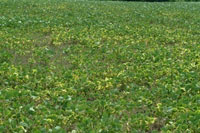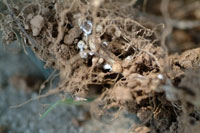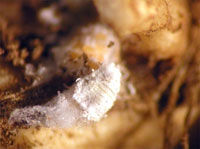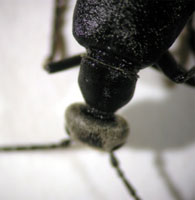

SORGHUM WEBWORM and CORN EARWORMS feeding on grain sorghum heads;
GRASSHOPPERS, HORNWORMS, and BUDWORMS are late season tobacco feeders;
GREEN STINK BUGS feeding on soybean pods;
check late-planted corn fields for damaging CORN BORER INFESTATIONS;
CRICKETS and other ACCIDENTAL INVADERS along foundations;
FRUIT FLIES in ripe fruits and vegetables;
WHITE GRUB damage in turf;
FOREIGN GRAIN BEETLES in newer homes.


 Samples of yellow, stunted plants were sent recently to the Plant Disease Diagnostic Lab from fields
in two different counties. Pictures on the left are from one of those fields. The general
symptoms appeared over distinct areas of the field.
Samples of yellow, stunted plants were sent recently to the Plant Disease Diagnostic Lab from fields
in two different counties. Pictures on the left are from one of those fields. The general
symptoms appeared over distinct areas of the field.
 Close examination of the root system revealed cottony white masses on the roots, often on
nodules. The material was produced by root mealybugs, aphid-like insects that use piercing
sucking mouthparts to feed on sap.
Close examination of the root system revealed cottony white masses on the roots, often on
nodules. The material was produced by root mealybugs, aphid-like insects that use piercing
sucking mouthparts to feed on sap.
 This picture shows a white wax-covered adult with some fibers behind and a mass of yellow-orange
eggs directly above her. The upper right portion of the picture is a nodule. Large stages of the
mealybug are visible to the naked eye and move slowly. The smallest nymphs are about the size of
a large mite. In addition to soybeans, these mealybugs were found on roots of volunteer alfalfa
and some scattered red clover in grass adjacent to the field. No mealybugs were found on a few
species of scattered broadleaf weeds in the bean field.
This picture shows a white wax-covered adult with some fibers behind and a mass of yellow-orange
eggs directly above her. The upper right portion of the picture is a nodule. Large stages of the
mealybug are visible to the naked eye and move slowly. The smallest nymphs are about the size of
a large mite. In addition to soybeans, these mealybugs were found on roots of volunteer alfalfa
and some scattered red clover in grass adjacent to the field. No mealybugs were found on a few
species of scattered broadleaf weeds in the bean field.
Feeding by this insect, coupled with hot, dry conditions clearly took a toll on many plants. As soil insects they are protected from insecticide applications so there is no effective rescue option at this point.
Foliar feeding mealybugs are familiar insects on houseplants and some soil mealybugs are pests in greenhouse systems but not much is known about the soil-dwelling species. There are several dozen species of soil mealybugs in the USSpecimens have been sent for identification.
For more information about soybean pests, visit
"Insect Management Recommendations".


 Blister beetles are out now. They feed on a wide range of plants including alfalfa, clover, soybean, potato, tomato, and eggplant and are especially attracted to flowers. Like the Japanese beetle, feeding by a few blister beetles draws in more. Large numbers of beetles can cluster on small patches of flowering plants in an otherwise uninfested field. This can result in infested hay. Blister beetles contain cantharadin, a chemical that is very toxic to horses. Fortunately, these insects have not been a significant problem in Kentucky alfalfa fields.
Blister beetles are out now. They feed on a wide range of plants including alfalfa, clover, soybean, potato, tomato, and eggplant and are especially attracted to flowers. Like the Japanese beetle, feeding by a few blister beetles draws in more. Large numbers of beetles can cluster on small patches of flowering plants in an otherwise uninfested field. This can result in infested hay. Blister beetles contain cantharadin, a chemical that is very toxic to horses. Fortunately, these insects have not been a significant problem in Kentucky alfalfa fields.
Harvest management is an important means of reducing the generally low potential for blister beetle contamination. Cutting on a schedule that keeps alfalfa and weeds from producing the flowers is effective. This results in high quality hay and keeps beetles at a minimum. However, if fields with lots or feeding blister beetles are cut and the hay is crimped or crushed, dead beetles in the hay can make it highly toxic to horses.
Fields can be checked visually for blister beetles before harvest. All areas with flowering plants must be visited because of the clumped nature of blister beetle aggregations. Sickle bar mowers and some circular or rotary mowers lay the hay down without crushing many beetles. As the hay cures, the beetles will leave.
Blister beetles have long (3/4" to 1-1/4"), narrow bodies, broad heads, and antennae that are about 1/3 the length of the entire body. The segment behind the head is narrow, so the beetle appears to have a "neck". The front wings are soft and flexible in contrast to the hard front wings of most beetles. The black blister beetle (jet black) and the margined blister beetle (black with thin gray stripe around wing covers) are common species in Kentucky.
Female blister beetles lay clusters of eggs in the soil in late summer. The small, active larvae that hatch from these eggs crawl over the soil surface entering cracks in search for grasshopper egg pods which are deposited in the soil. After finding the eggmass, blister beetle larvae become immobile and spend the rest of their developmental time as legless grubs. Blister beetles will not lay eggs in hay and the larvae do not feed on or develop in hay bales.
See Insect Recommendations
for more alfalfa pest recommendations.



Insects & Mites:
There are three insects (one is a group of insects) and a mite that pose a threat to wheat in the fall. The "cereal" aphids are known for their ability to move the yellows viruses that cause Barley yellow dwarf. This is actually a large group of aphid species. Generally there are five species common in Kentucky, of which the bird cherry-oat aphid is the most important. The wheat curl mite may also cause considerable damage to wheat due largely to its' ability to move wheat streak mosaic virus. The other two insects, the Hessian fly and the fall armyworm, are problematic due to direct feeding on the plant. Although this is a quite diverse group of pests, all of them are affected by several common cultural concerns.
Cultural Concerns: All of these fall pests have two important aspects in common: short term weather, especially temperature and the "green bridge". All insect development, that is, the rate at which they grow, feed, move and reproduce, etc. is largely governed by temperature. Additionally, in general, once a hard frost has occurred, and daily average temperatures fall below about 50oF, these insect pests will be less important. In a warmer fall that lasts later into the year, these pests are likely to have a greater impact on the crop. Though there is nothing we can do about the short term weather, it is important that we understand when our crops are at greater risk to pests because of weather.
Another important cultural concern is the presence of a "green bridge". This "green bridge" is generally considered to be the presence of a host plant (usually volunteers of a crop plant) present throughout a break period from the previous crop to the emergence of the new crop. In wheat, this is most likely to occur in areas where wheat is grown as a single crop for most of the year, with only a short time between crops (e.g. Great Britain, American dry land west). In Kentucky, we usually have a full summer between our wheat crops and our fields are often rotated. These items usually prevent the "green bridge", but not always.
In the past several years, we have witnessed the presence of considerable over-summering volunteer wheat, and volunteer corn that has germinated after harvest. Both of these crops can provide the makings of a green bridge or an early start-up, for one or more of our fall pests. In particular during the drought of 2007, we saw considerable volunteer wheat from seed that had laid dormant during the hot dry summer, but germinated in early September, providing a host long before production wheat was planted. Additionally, in 2007 there was a marked increase of volunteer corn that emerged along with the production wheat. Both of these volunteer hosts, occurred in a fall that lasted quite late into the year, and the volunteers were often within fields of production wheat or very near.
Volunteer wheat and corn can serve as host plants for all of these fall pests. All of these pests can feed and reproduce on these crops and both corn and wheat can serve as a reservoir for the aphid and mite born viruses that result in barley yellow dwarf and wheat streak mosaic.
Volunteer hosts particularly wheat that are present through the summer or well before the planting and emergence of our crop allows these pests to continue their life cycles through the summer, or to get a head start on their fall population development. Preventing/removing these hosts should play an important role in preventing problems from these pests. For example, in every case that we have seen the wheat curl mite and the resulting damage from wheat streak mosaic, has been in association with volunteer wheat. In speaking with colleagues in Nebraska, the presence of volunteer wheat is nearly always the cause of this problem. Additionally, in 2007 when a large population of fall armyworm was noted, many production wheat fields which contained volunteer corn were infested. Fortunately, fall armyworms prefer corn and generally stayed on the corn plants within the wheat field! This situation may not have ended so well had the pest in question been the wheat curl mite (and we would not have known this until wheat streak mosaic symptoms showed in the spring).
Certainly it is not possible to remove all alternative hosts, particularly during the summer. Corn, for example, is a crop during the summer and in Kentucky we generally plant wheat following a corn crop. But even with corn, we should strive for a break period between corn harvest and wheat emergence where there are no live plants (especially grass weeds, e.g. Johnson grass). Additionally, there are many other wild grasses and grass weed hosts on which these pests can live. However, managing to eliminate these crop plants as volunteers in production fields, as early as possible, especially in the fields that are planned for wheat production, can greatly aid in reducing the impact of these pests.
So what can/should you do?
A concluding note about controlling volunteer crops; In this issue, Dr. Jim Martin has provided information on control of these crop as weeds. Please read this article. Just remember, from the insect management standpoint, these crops must be dead, not dying, to prevent pest build up. Techniques that do not kill the plants (mowing, for example) will not work. Techniques that kill the plants slowly will allow the pests to remain until the host plants are dead.
See "Insect Management Recommendations" for more wheat pest information.


Current combines are efficient but not perfect. It is not unusual to leave some crop seed in the field resulting in volunteer plants. Volunteer corn and wheat are examples that often occur in Kentucky. We tend to overlook these as being a serious threat to wheat, yet there are cases where growers may need to control them.
VOLUNTEER CORN: Last season there were many fields that appeared almost solid green with volunteer plants after corn harvest. Part of this may be attributed to the stress of last summer's dry weather which limited kernel size and allowed more seed to pass through the combine. Improper adjustment of combines may be another reason for greater than normal seed loss. Even though 2% is considered acceptable loss, this could leave a substantial amount of corn seed for fields averaging 200 or more bu/A.
There is some debate whether volunteer corn is a threat to wheat. One viewpoint is that volunteer plants will eventually be killed from fall's freezing temperatures before they can impact wheat. Another opinion is that early-season competition from volunteer corn will impact growth and yield of wheat.
Limited research this past season showed 11% lower wheat yield if volunteer corn was not controlled. It is not clear if this trend in yield loss will hold true for every case, but it does show significant economic losses can occur from volunteer corn competition.
The germination pattern of volunteer corn may be uniform or sporadic depending on a number of factors including duration and pattern of rainfall following harvest. Volunteer corn at UKREC germinated uniformly last season due to the rainfall over a six-day period soon after corn harvest and a three-day period approximately two weeks later. The development of volunteer corn was fairly uniform and ranged from 6 to 8½ inches tall at the time of planting wheat in mid October. Sporadic germination patterns that are associated with irregular rainfall may make it difficult to determine the optimum time for controlling volunteer corn. It is possible that implementing control options well ahead of wheat planting will allow for escapes if seed germination is extended over a long period.
The options for managing volunteer corn include tillage or a foliar applied herbicide. Tillage provides immediate results, but may increase the risk of soil erosion and more time relative to using burndown herbicides. While tillage will destroy emerged volunteer corn plants, it may stimulate germination of any remaining seeds that were incorporated in the soil during the tillage process.
Glyphosate controls volunteer corn providing plants do not originate from corn with the 'glyphosate-tolerant' or Roundup Ready trait. The fact a significant number of Kentucky's corn acres are planted to glyphosate-tolerant hybrids limits the opportunity to use glyphosate. Glyphosate usually requires 7 or more days to kill plants; consequently, it may not be the right choice if immediate control is needed.
Paraquat provides rapid control of vegetation; therefore, it may be preferred over glyphosate if speed of control is desired. Paraquat helps manage volunteers with GMO traits, including glyphosate-tolerant corn. Paraquat alone tends to be inconsistent in controlling corn that originates from seed that were planted or incorporated in soil. We have seen this when we try to kill corn for replant situations in the spring. However, limited research last fall showed at least 95% control for corn plants from seeds that were not incorporated into soil. Our current theory is that the growing points of volunteer corn plants originated from seed on or near the soil surface and were exposed to paraquat and other related stresses.
Research on the use of Finesse showed up to 60% control of volunteer corn within 7 days after planting no-till wheat. Finesse is a premix of ALS inhibitor herbicides and is slow in its activity. Unfortunately frost occurred before Finesse reached maximum activity; consequently we were unable to determine if the herbicide would have eventually killed the volunteer plants. Plans are to do additional research to determine if Finesse is an option for managing volunteer corn in no-till wheat. The advantage of Finesse is that it would likely provide residual activity for any later emerging volunteer plants as well as help in managing Italian ryegrass. The rotational crop restrictions for Finesse require an interval of at least 6 months before planting STS soybeans.
VOLUNTEER WHEAT: Most volunteer wheat seed germinate after wheat harvest, however, it is possible for seed to survive 16 months, and in some cases up to 2 years before germinating. While volunteer wheat plants usually succumb to heat, dry soil, and diseases, there are cases where they survive up through planting of this fall's wheat crop. The fact that most if not all of Kentucky wheat is grown in a rotation with other crops, limits the chances of direct competition of volunteer wheat to this fall's wheat crop, yet the surviving volunteers could serve as host to other pests that will cause a problem to neighboring fields planted to wheat.
Options for controlling volunteer wheat are similar to those mentioned for volunteer corn and include tillage or a burndown application of either glyphosate or paraquat. Keep in mind that control of volunteer wheat with paraquat may be inconsistent when wheat plants are tillering.
The following table lists approximate costs for tillage and burndown herbicides.
| Approximate Costs for Controlling Volunteer Corn or Wheat | |
|---|---|
| Method | Approximate Cost1 |
| Tillage with tandem disc | $ 11.50/A |
| Gramoxone Inteon (paraquat) | |
| 2 to 2.5 pt/A (1-3" weeds) | $13.25-15.00/A |
| 2.5 to 3. pt/A (3-6" weeds) | $15.00-16.50/A |
| 3 to 4 pt/A (6" weeds) | $16.50-20.00/A |
| Roundup PowerMax (glyphosate) | |
| 11 oz/A (6" weeds) | $11.75/A |
| 16 oz/A (12" weeds) | $13.50/A |
| 22 oz/A (18" wheat) (20" corn) | $15.50/A |


During the past week, the PDDL received samples of black shank, soreshin, and blue mold on tobacco; downy mildew and sudden death syndrome on soybean; and Rhizoctonia crown rot and summer black stem on alfalfa.
On fruits, vegetables and herbs, we diagnosed Rhizoctonia root and stem rot on basil; root knot nematode, Fusarium wilt, Septoria leaf spot, and tobacco mosaic virus on tomato; zucchini yellow mosaic virus on melon; gummy stem blight and POTY virus on watermelon; and powdery mildew on squash.
On ornamentals and turf, we have seen Rhizoctonia root and stem rot on vinca; foliar nematodes on hosta; Pythium root rot on lily and petunia; fire blight on pear; Cercospora leaf spot on redbud; Cytospora canker on willow; summer patch on bluegrass; and Gaeumannomyces root decline on zoysiagrass.


August 15-22, 2008
UKREC-Princeton, KY
| Black Cutworm
| 2
| True Armyworm
| 1
| Corn Earworm
| 17
| European Corn Borer
| 2
| Southwestern Corn Borer
| 8
| Fall armyworm
| 3
| | |
Lexington, KY
| Black Cutworm
| 2
| True Armyworm
| 1
| Corn Earworm
| 4
| European Corn Borer
| 0
| Southwestern Corn Borer
| 0
| Fall armyworm
| 0
| | |
Graphs of insect trap counts are available on the IPM web site at - http://www.uky.edu/Ag/IPM/ipm.htm. View trap counts for Fulton County, Kentucky at - http://ces.ca.uky.edu/fulton/anr/
NOTE: Trade names are used to simplify the information presented in this newsletter. No endorsement by the Cooperative Extension Service is intended, nor is criticism implied of similar products that are not named.
Lee Townsend
Extension Entomologist